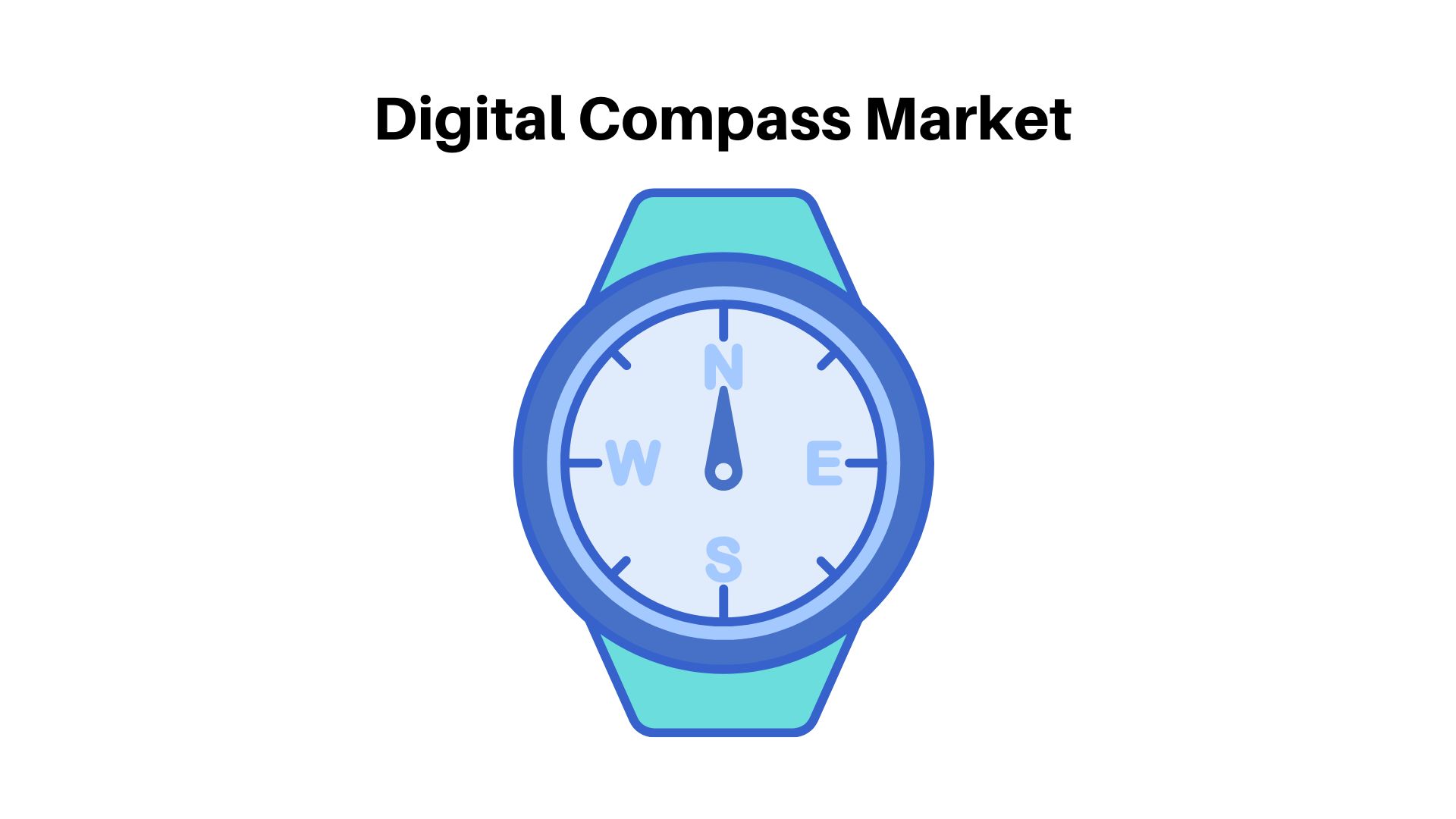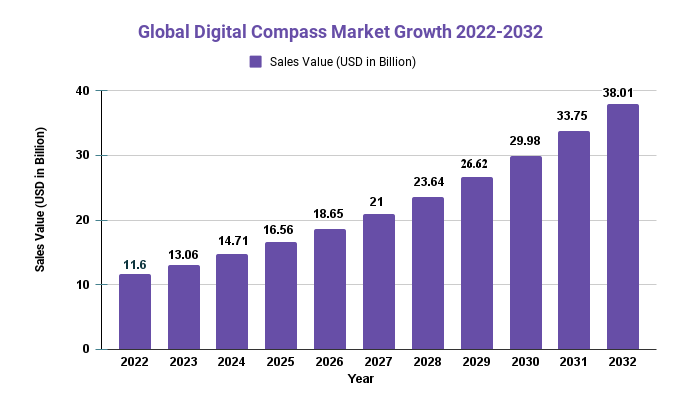Digital Compass Market Size Is Set To Expand With CAGR Of 12.60% By 2032

Page Contents
Published Via 11Press: The Digital Compass Market size is expected to be worth around USD 38.01 Bn by 2032 from USD 11.60 Bn in 2022, growing at a CAGR of 12.60% during the forecast period from 2022 to 2032.
Digital Compass/ Electronic compass (ecompass) is a device that uses Earth's magnetic fields to determine direction of travel. Ecompasses consist of multiple components, such as magnetometer, accelerometer and gyroscope. Most modern ecompasses feature an embedded microcontroller (MCU) which subtracts automobile magnetic fields (distortion) and intensified earth magnetic field for precise readings on their compass needle.
Due to their precise North Pole determination capabilities, electronic compasses are in high demand among defense, aerospace and military markets. Trail makers, hikers and bikers as well as mapmakers find these e-compasses invaluable due to the reduced risk of interferences while undertaking adventurous activities.
The digital compass market is a rapidly growing segment of the technology sector. A digital compass, commonly found in smartphones, tablets, GPS units and other electronic gadgets, serves to determine magnetic north pole direction. With an increasing need for navigation and location-based services – particularly within automotive and consumer electronics sectors – digital compasses will continue to see strong demand in this space.
Request For Sample Report Before Purchasing Here: https://market.us/report/digital-compass-market/request-sample/
The market for digital compasses is projected to expand at a steady rate over the coming years, due to rising demand for high-quality navigation and location-based services. Furthermore, this growth is being fuelled by their increasing adoption across various applications such as consumer electronics, automotive, marine, and military.
The consumer electronics segment, consisting of smartphones and tablets, is the largest segment in the digital compass market. Rising demand for location-based services and navigation features on smartphones has fuelled this growth segment, while automotive OEMs are playing an increasingly significant role in expanding vehicle adoption of digital compasses due to advances in advanced driver assistance systems (ADAS) and autonomous driving technology.
Asia-Pacific is the leading market for digital compasses, with China, Japan and South Korea dominating this region. This growth has been fuelled by the increasing adoption of these compasses in smartphones and other consumer electronics products.
Overall, the digital compass market is expected to experience steady growth over the coming years due to an increasing need for navigation and location-based services across various industries. Furthermore, technological advances such as improved accuracy, sensitivity, and power consumption should further fuel this industry expansion.
Key Takeaways
- The digital compass market grew to USD 11.60 Billion in 2022.
Forecasted compound annual growth rates between 2022 and 2032 is 12.60%.
By 2032, the digital compass market is projected to reach USD 38.01 Billion. - The digital compass market is a rapidly expanding segment of the technology sector, driven by an increasing need for navigation and location-based services.
- The market for digital compasses is being fuelled by their growing adoption across various applications, such as consumer electronics, automotive, marine and military.
- The consumer electronics sector, consisting primarily of smartphones and tablets, is the largest segment in the digital compass market.
- The automotive sector is a major contributor to the growth of the digital compass market, due to rising demand for advanced driver assistance systems and autonomous vehicles.
- Asia-Pacific is the leading market for digital compasses, with China, Japan and South Korea dominating this region.
- The digital compass market is expected to experience steady growth over the coming years, driven by increasing demand for location-based services and navigation features across various industries.
- Technological improvements in accuracy, sensitivity, and power consumption are predicted to propel the growth of the digital compass market.

Regional Analysis
- North America holds a leading position in the digital compass market, due to its rising adoption among automotive applications. Furthermore, rising demand for advanced driver assistance systems and autonomous vehicles is fueling growth within this region.
- Europe is a major market for digital compasses, driven by the automotive and consumer electronics sectors. The increasing adoption of location-based services and navigation features on smartphones has further contributed to this expansion in the region.
- The Asia-Pacific region is the leading market for digital compasses, due to their growing adoption in smartphones and other consumer electronics products. China, Japan, and South Korea are three major players in this space.
- Middle East and Africa The digital compass market in the Middle East and Africa region is expected to experience steady growth over the coming years, driven by an increasing adoption of these compasses for automotive and military applications.
- Latin America The digital compass market in Latin America is expected to expand at a moderate pace over the coming years due to their increasing adoption across consumer electronics and automotive applications.
- Overall, the digital compass market is expected to expand steadily across all regions due to rising demand for navigation and location-based services. Furthermore, this sector will see an uptick in adoption of digital compasses across various applications such as consumer electronics, automotive, marine, and military.
Purchase This Report Via This Secured Link and Avail Discount: https://market.us/purchase-report/?report_id=56180
Drivers
The growing demand for navigation and location-based services As consumers increasingly rely on these features in various applications such as smartphones, tablets, and vehicles, the digital compass market is expected to experience significant growth. Adoption of digital compasses in consumer electronics The growing use of digital compasses in consumer electronics such as smartphones, tablets, and wearables are fueling the growth of this market. These devices require navigation and location-based services to operate properly without them, these devices would not function properly.
The automotive sector is increasingly adopting digital compasses for advanced driver assistance systems (ADAS) and autonomous vehicles, as these require precise navigation and location-based services hence, digital compasses play an integral role in their operation. The military and defense sector is increasingly turning to digital compasses for navigation, surveillance, and other applications. The increasing defense spending by various countries is fueling this market growth. Technological Advancements The development of advanced digital compasses that are more precise, sensitive, and energy efficient is propelling the growth of this market. These innovations have allowed digital compasses to be adopted into new applications, further expanding its reach within the industry.
Overall, the digital compass market is being driven by rising demand for navigation and location-based services across various applications, technological advancements, as well as increased adoption of digital compasses in automotive and defense applications.
Restraints
Availability of Alternative Technologies The presence of alternatives such as GPS, GLONASS, and BeiDou systems could potentially limit the growth in the digital compass market. These systems offer accurate navigation and location-based services that may be preferred over digital compasses. High Costs The high price tag associated with digital compasses may restrict their use in certain applications, particularly those in developing countries. For some businesses, this cost could prove a substantial deterrent.
Dependence on External Factors Digital compasses is susceptible to external factors like electromagnetic interference and temperature changes, which could compromise their accuracy. This dependence may prevent their adoption into certain applications. Limited Accuracy Digital compasses have limitations in their accuracy, particularly in urban settings with many sources of interference. This limitation may prevent their widespread adoption in certain applications. Lack of Awareness Lack of understanding regarding the advantages and applications of digital compasses may hinder their adoption, particularly in developing countries.
Overall, the digital compass market is expected to expand at a steady rate however, certain constraints may restrict its expansion in certain applications and regions.
Opportunities
Expansion into Emerging Markets Emerging economies such as India, Brazil, and South Africa offers significant potential for the digital compass market. These countries have an increasing demand for location-based services and navigation features in various applications like smartphones, wearables, and vehicles. Adoption in New Applications The development of advanced digital compasses with higher accuracy and sensitivity has opened the door for their use in various applications such as drones, robotics, and augmented reality. These new markets present tremendous growth and expansion prospects for this sector.
Integration with Other Technologies Connecting digital compasses to other technologies like GPS, GLONASS, and BeiDou systems offer opportunities for creating more sophisticated navigation and location-based services. This integration can improve their accuracy and dependability. Growing Demand in the Automotive Sector The rising popularity of advanced driver assistance systems (ADAS) and autonomous vehicles presents significant growth prospects for the digital compass market. Digital compasses are necessary components in these systems to provide accurate navigation and location-based services. Adoption in the Military and Defense Sector The rapidly increasing adoption of digital compasses within this sector presents significant growth and expansion prospects. There is an expanding need for navigation and surveillance systems, which in turn are fueling demand for digital compasses.
Overall, the digital compass market offers several prospects for growth and expansion, such as expansion into emerging markets, adoption of new applications, integration with other technologies, increasing demand in automotive applications, and increased adoption within military and defense applications.
Challenges
Competition from Alternative Technologies The digital compass market is facing competition from alternative technologies such as GPS, GLONASS, and BeiDou systems that provide precise navigation and location-based services. With the increasing adoption of these systems, the growth of the digital compass market could be hindered. Dependence on External Factors Digital compasses is sensitive to external influences like electromagnetic interference and temperature changes, which could impact their accuracy. This dependency may prevent their adoption in certain applications due to potential limitations.
Lack of Standardization The absence of standards in digital compass technology may hinder its adoption and expansion. Without common guidelines, users may experience compatibility problems when integrating these instruments into their systems. Integration Challenges Integrating digital compasses into existing systems can present difficulties, particularly complex ones like ADAS and autonomous vehicles. These integration issues could limit their use in these settings. High Costs The high price tag associated with digital compasses may hinder their widespread adoption in certain applications, particularly those in developing countries. For some companies, this cost barrier could prove a substantial deterrent.
Overall, the digital compass market offers significant potential for expansion and growth however, it also faces several obstacles which could restrict adoption and progress. Addressing these issues is essential if we wish to sustainably see continued progress within this space.
Key Market Segments
Type
- LTE
- LTE-A
Application
- Automotive
- Aeronautics
- Defense
- Other
Key Market Players
- ST Microelectronics
- Robert Bosch
- Texas Instruments
- Asahi Kasei Microdevices
- Bell Automotive Products
- Baolab Microsystems
- Honeywell International
- Sparton Corporation
- BARIGO Barometerfabrik GmbH
FAQ.
The digital compass market is growing at a CAGR of 12.60%
Asia Pacific is growing at the highest CAGR over 2022- 2032.
North America holds the highest share in 2022.
ST Microelectronics, Robert Bosch, Texas Instruments, Asahi Kasei Microdevices, Bell Automotive Products, Baolab Microsystems, Honeywell International, Sparton Corporation and BARIGO Barometerfabrik GmbH
The team behind market.us, marketresearch.biz, market.biz and more. Our purpose is to keep our customers ahead of the game with regard to the markets. They may fluctuate up or down, but we will help you to stay ahead of the curve in these market fluctuations. Our consistent growth and ability to deliver in-depth analyses and market insight has engaged genuine market players. They have faith in us to offer the data and information they require to make balanced and decisive marketing decisions.



